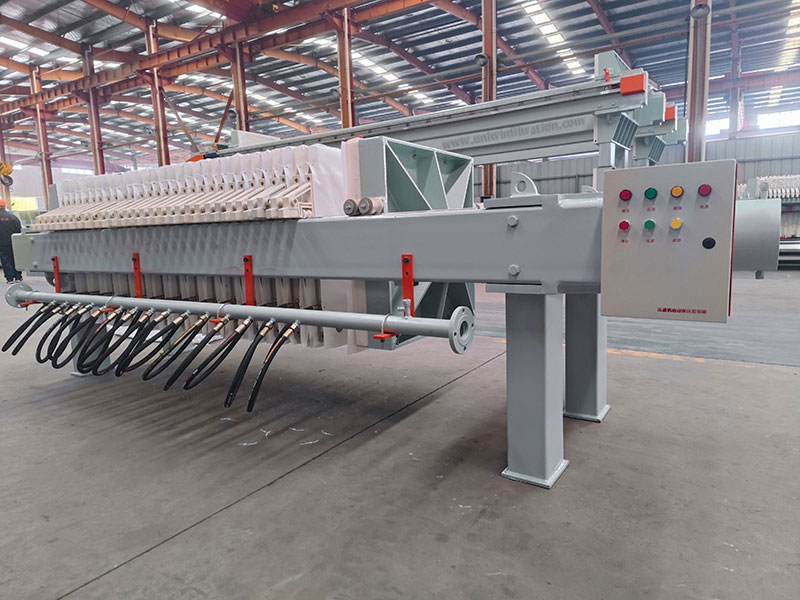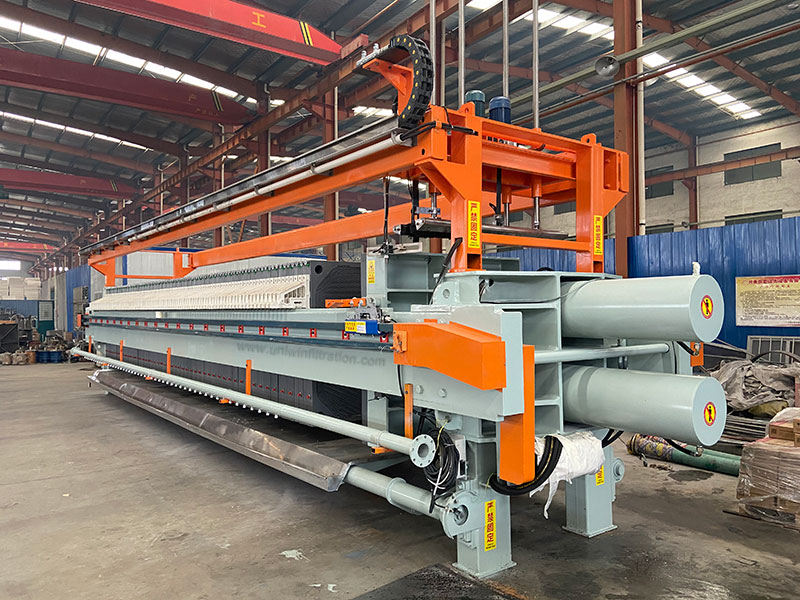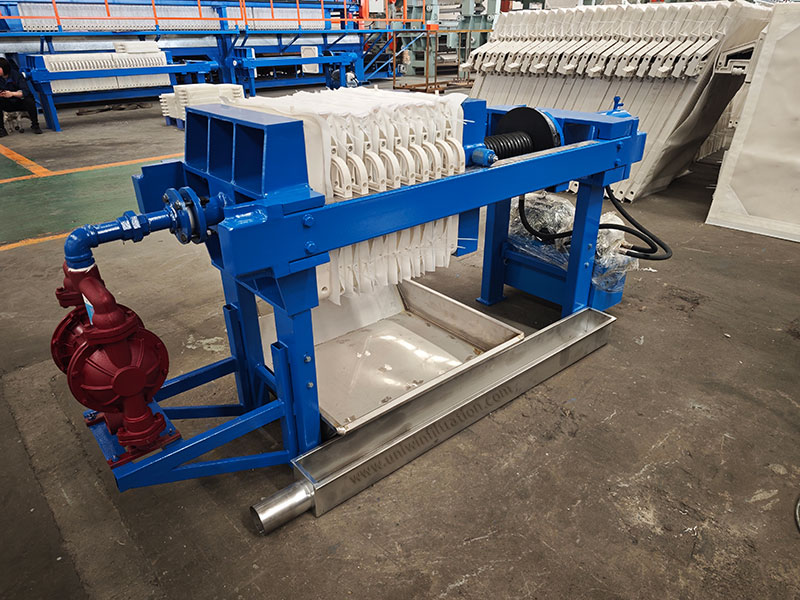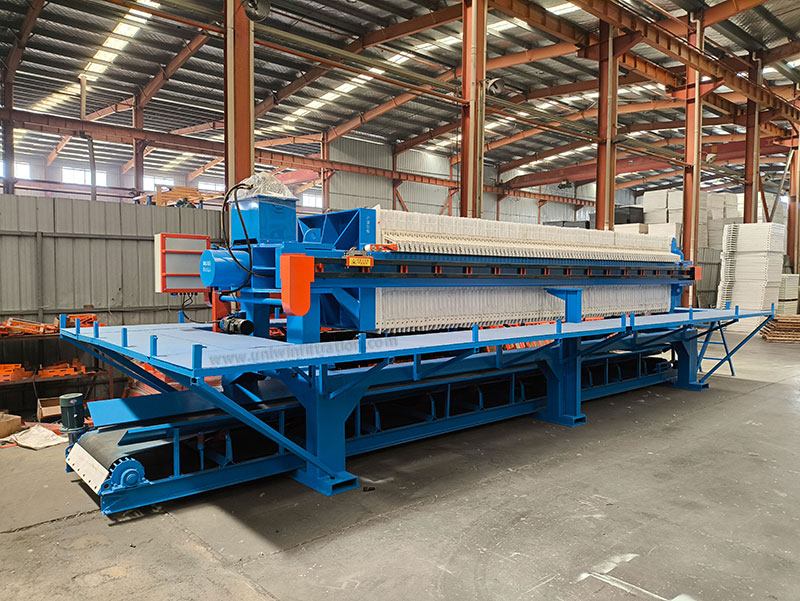Diaphragm Filter Press
Diaphragm filter press is a highly efficient solid-liquid separation equipment, widely used in chemical, pharmaceutical, food, environmental protection, mining, and metallurgy and other fields, especially suitable for occasions with low requirements for filter cake moisture content. Compared with an ordinary chamber filter press, a diaphragm filter press has obvious advantages in squeezing and dehydration. The following is a detailed introduction to the diaphragm filter press.
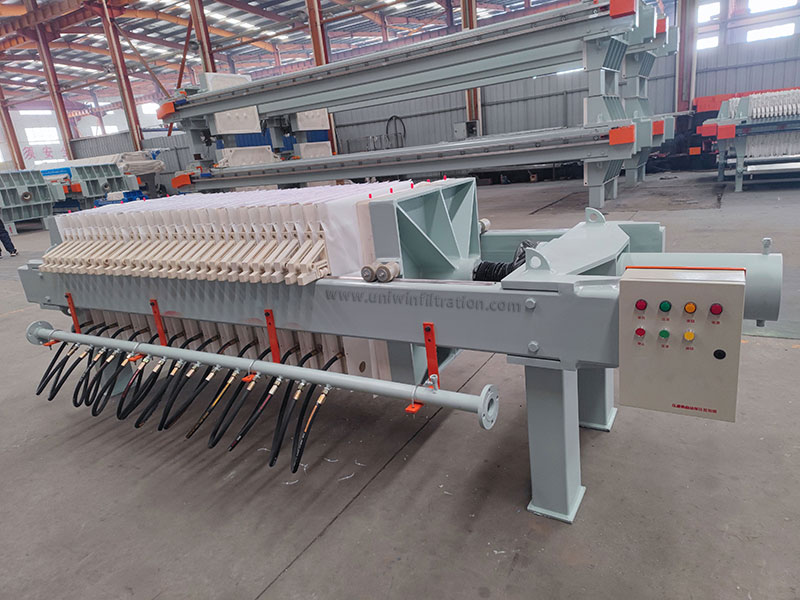
Working Principle of Membrane Filter Press
The working process of the diaphragm filter press mainly includes two stages: feed filtration and diaphragm pressing.
Feed filtration stage:
The suspension is pumped into each filter chamber by the feed pump, where the liquid passes through the filter cloth while the solids are retained on its surface, gradually forming a filter cake.
Diaphragm pressing stage:
When the filter cake is initially formed, by injecting compressed air or liquid into the diaphragm plate (usually rubber or polypropylene material), the diaphragm begins to expand, thereby further squeezing the filter cake, expelling the residual water therein, and significantly reducing the moisture content of the filter cake.

Diaphragm Filter Press Parameters
| Model | Filter area (m2) | Plate size (mm) | Cake thickness (mm) | Filter chamber volume (L) | Plate Quantity (pcs) | Filtration pressure (Mpa) | Motor Power(Kw) | Weight (Kg) | Dimensions LxWxH(mm) |
|---|---|---|---|---|---|---|---|---|---|
| XMGY30/870-U | 30 | 870*870 | ≤35 | 498 | 23 | ≤0.8 | 4 | 3046 | 3880*1250*1300 |
| XMGY40/870-U | 40 | 870*870 | ≤35 | 623 | 29 | ≤0.8 | 4 | 3593 | 4270*1250*1300 |
| XMGY50/870-U | 50 | 870*870 | ≤35 | 789 | 37 | ≤0.8 | 4 | 4057 | 4790*1250*1300 |
| XMGY60/870-U | 60 | 870*870 | ≤35 | 955 | 45 | ≤0.8 | 4 | 4597 | 5310*1250*1300 |
| XMGY70/870-U | 70 | 870*870 | ≤35 | 1121 | 53 | ≤0.8 | 4 | 5136 | 5830*1250*1300 |
| XMGY80/870-U | 80 | 870*870 | ≤35 | 1287 | 61 | ≤0.8 | 4 | 5636 | 6350*1250*1300 |
| XMGY50/1000-U | 50 | 1000*1000 | ≤35 | 776 | 27 | ≤0.8 | 4 | 4352 | 4270*1500*1400 |
| XMGY60/1000-U | 60 | 1000*1000 | ≤35 | 943 | 33 | ≤0.8 | 4 | 4480 | 4770*1500*1400 |
| XMGY70/1000-U | 70 | 1000*1000 | ≤35 | 1109 | 39 | ≤0.8 | 4 | 5263 | 5130*1500*1400 |
| XMGY80/1000-U | 80 | 1000*1000 | ≤35 | 1275 | 45 | ≤0.8 | 4 | 5719 | 5560*1500*1400 |
| XMGY100/1000-U | 100 | 1000*1000 | ≤35 | 1608 | 57 | ≤0.8 | 4 | 6555 | 6410*1500*1400 |
| XMGY120/1000-U | 120 | 1000*1000 | ≤35 | 1941 | 69 | ≤0.8 | 4 | 7466 | 7260*1500*1400 |
| XMGY80/1250-U | 80 | 1250*1250 | ≤40 | 1560 | 29 | ≤0.8 | 5.5 | 10900 | 4830*1800*1600 |
| XMGY100/1250-U | 100 | 1250*1250 | ≤40 | 1975 | 37 | ≤0.8 | 5.5 | 11750 | 5440*1800*1600 |
| XMGY120/1250-U | 120 | 1250*1250 | ≤40 | 2391 | 45 | ≤0.8 | 5.5 | 12600 | 6060*1800*1600 |
| XMGY150/1250-U | 150 | 1250*1250 | ≤40 | 2911 | 55 | ≤0.8 | 5.5 | 13620 | 6820*1800*1600 |
| XMGY160/1250-U | 160 | 1250*1250 | ≤40 | 3119 | 59 | ≤0.8 | 5.5 | 14470 | 7130*1800*1600 |
| XMGY200/1250-U | 200 | 1250*1250 | ≤40 | 3847 | 73 | ≤0.8 | 5.5 | 15320 | 8200*1800*1600 |
| XMGY240/1250-U | 240 | 1250*1250 | ≤40 | 4679 | 89 | ≤0.8 | 5.5 | 16170 | 9420*1800*1600 |
| XMGY250/1250-U | 250 | 1250*1250 | ≤40 | 4783 | 91 | ≤0.8 | 5.5 | 17020 | 9570*1800*1600 |
| XMGY200/1500-U | 200 | 1500*1500 | ≤40 | 3809 | 49 | ≤0.8 | 11 | 26120 | 7140*2200*1820 |
| XMGY250/1500-U | 250 | 1500*1500 | ≤40 | 4723 | 61 | ≤0.8 | 11 | 26930 | 7730*2200*1820 |
| XMGY300/1500-U | 300 | 1500*1500 | ≤40 | 5637 | 73 | ≤0.8 | 11 | 28160 | 8720*2200*1820 |
| XMGY350/1500-U | 350 | 1500*1500 | ≤40 | 6551 | 85 | ≤0.8 | 11 | 29600 | 10110*2200*1820 |
| XMGY400/1500-U | 400 | 1500*1500 | ≤40 | 7618 | 99 | ≤0.8 | 11 | 31500 | 11260*2200*1820 |
| XMGY450/1500-U | 450 | 1500*1500 | ≤40 | 8532 | 111 | ≤0.8 | 11 | 33400 | 12250*2200*1820 |
| XMGY500/1500-U | 500 | 1500*1500 | ≤40 | 9446 | 123 | ≤0.8 | 11 | 33380 | 13240*2200*1820 |
| XMGY600/2000-U | 600 | 2000*2000 | ≤40 | 11901 | 85 | ≤0.8 | 15 | 54164 | 13030*3000*2500 |
| XMGY700/2000-U | 700 | 2000*2000 | ≤40 | 13838 | 99 | ≤0.8 | 15 | 58300 | 14390*3000*2500 |
| XMGY800/2000-U | 800 | 2000*2000 | ≤40 | 14945 | 107 | ≤0.8 | 15 | 62460 | 15770*3000*2500 |
| XMGY900/2000-U | 900 | 2000*2000 | ≤40 | 17713 | 127 | ≤0.8 | 15 | 66620 | 17150*3000*2500 |
| XMGY1000/2000-U | 1000 | 2000*2000 | ≤40 | 19651 | 141 | ≤0.8 | 15 | 70780 | 18530*3000*2500 |
Diaphragm Filter Press VS Ordinary Filter Press
- Pressing method: Ordinary filter presses only rely on the pressure of the feed pump for filtration, while diaphragm filter presses add secondary diaphragm pressing after the initial filtration to improve dehydration efficiency.
- Moisture content of filter cake: Ordinary filter presses have a relatively high moisture content and incomplete dehydration, while membrane filter presses have a low moisture content, making the filter cake drier and easier to transport and process.
- Filtration cycle: Ordinary filter presses have a long filtration time and relatively low processing efficiency, but diaphragm filter presses accelerate solid-liquid separation through diaphragm pressing, and the overall cycle is shorter.
- Applicable working conditions: Ordinary filter presses are suitable for conventional filtration occasions that do not require high filter cake thickness, while diaphragm filter presses are suitable for working conditions that require high dehydration rate, efficiency, and automation.
- Equipment structure: Ordinary filter presses filter directly between filter plates, and diaphragm filter plates are equipped with expandable diaphragms to increase the extrusion function.
- Maintenance complexity: Ordinary filter presses have a simple structure and are relatively easy to maintain. The diaphragm system requires regular maintenance to ensure long-term stable operation.
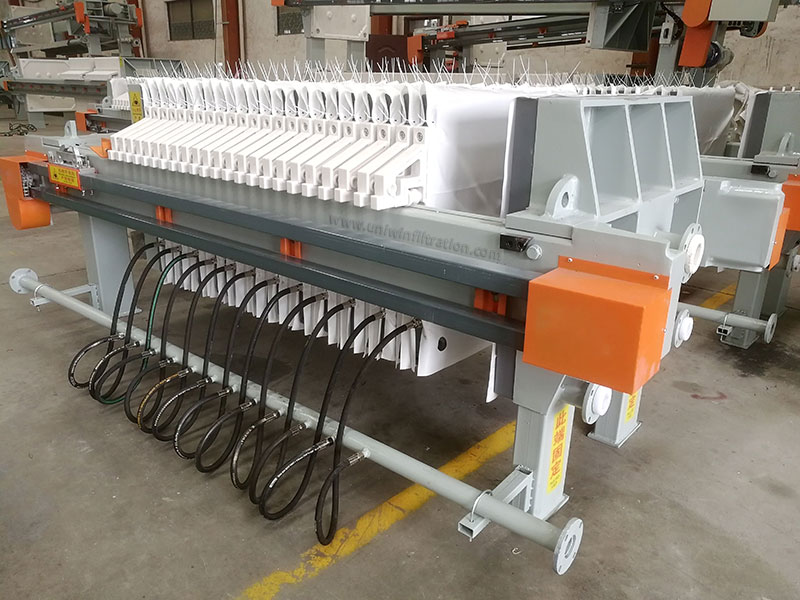
Advantages of the Diaphragm Filter Press
Lower filter cake moisture content
Diaphragm filter press can further discharge residual water in the filter cake through “secondary squeezing” (that is, after the filter cake is formed, the diaphragm plate expands inward to squeeze the filter cake), and the moisture content can be 5%-20% lower than that of an ordinary filter press. This is especially important for industries that require dry stacking, incineration, or saving transportation costs.
Shorter filtration cycle
Ordinary filter presses rely only on the pressure of the feed pump for filtration, and the dehydration process of the filter cake is slow. However, the diaphragm filter press quickly squeezes after the filtration is completed, speeding up the discharge of the filtrate, effectively shortening the complete filtration cycle, and improving the overall processing efficiency.
Dense filter cake structure
After diaphragm pressing, the filter cake is more uniform, denser, less prone to breakage, smaller in size, and easier to stack, reducing the difficulty and cost of subsequent processing links, and is particularly suitable for scenarios with specific requirements for filter cake processing.
Improve filtrate clarity and recovery rate
Secondary pressing helps to squeeze out part of the liquid entrained in the filter cake again, improving the filtrate yield, especially in the processing of high-value liquid phase, such as pharmaceutical intermediates, fine chemical extraction, etc., the effect is more obvious.

